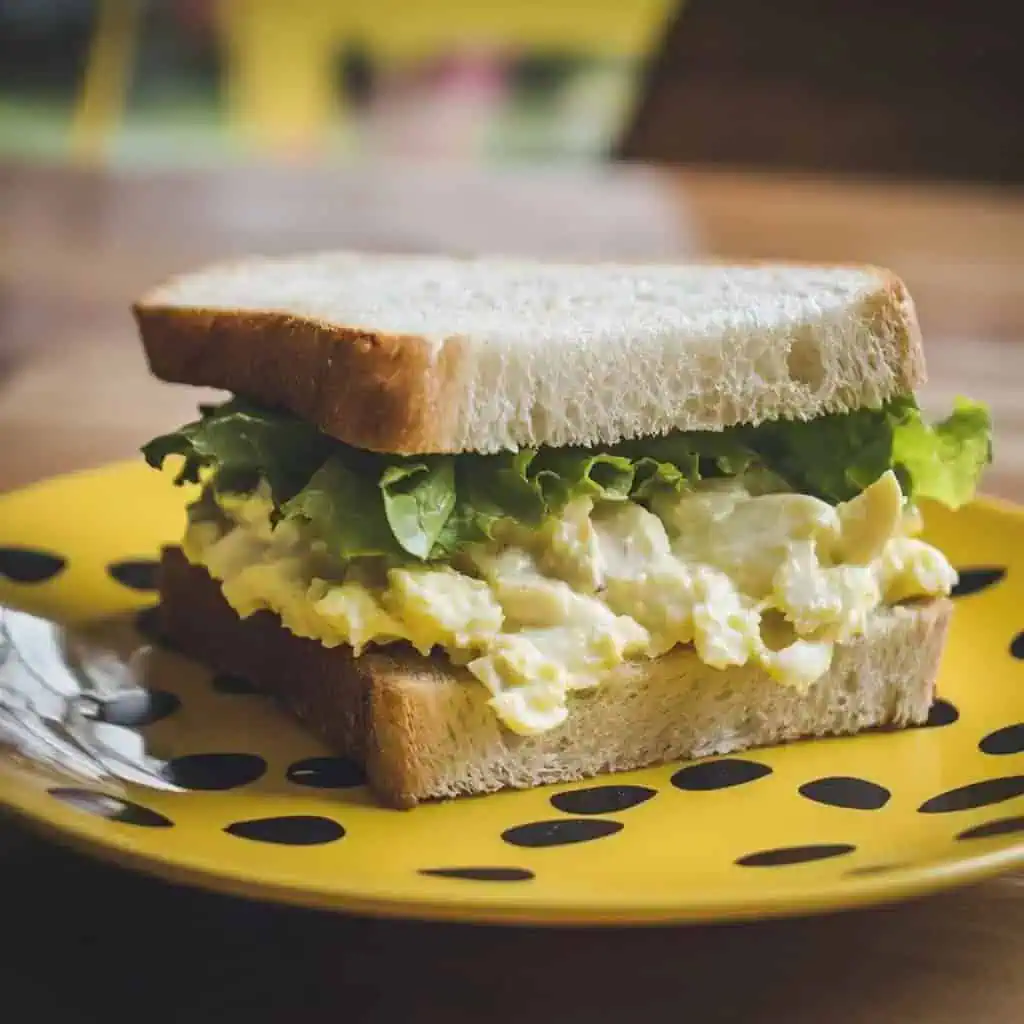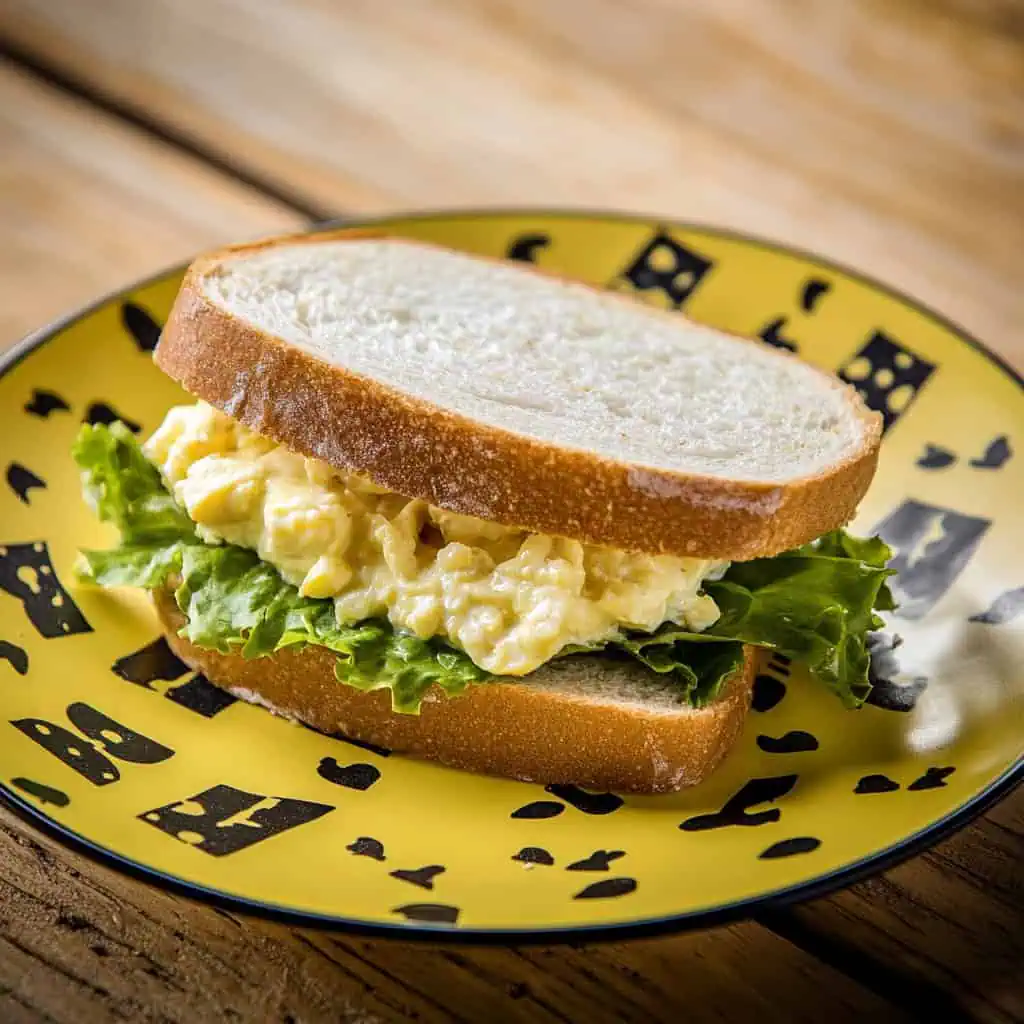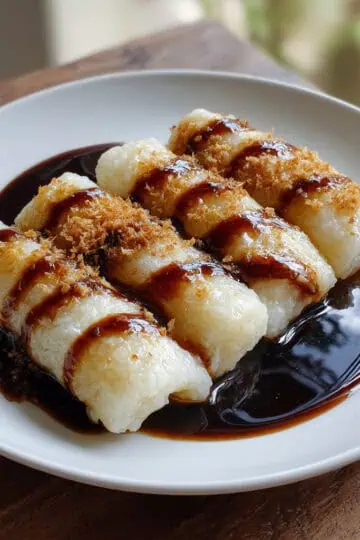You know that feeling when you open your baon at school and find your favorite egg sandwich inside? That's exactly what this recipe is all about! As someone who grew up in a Filipino home, this egg sandwich spread was (and still is!) my absolute favorite. My mom taught me how to make it when I was young, and now I make it for my own kids. It's super simple: just eggs, mayo, and onions - but there's something so special about how these basic ingredients come together.
What I love most about this recipe is that anyone can make it. You don't need fancy ingredients or amazing cooking skills. In just 15 minutes, you can whip up a creamy, delicious spread that's perfect for any bread, whether it's pandesal fresh from the bakery or regular sliced bread from the grocery.
Try it once, and I promise it'll become your go-to recipe for baon and merienda!
Jump to:

Why You'll Love This Recipe
- Ready in just 15 minutes
- Budget-friendly ingredients
- Perfect for meal prep
- Kid-approved favorite
- Protein-rich and filling
- Customizable to taste
- Great for baon (packed lunch)
- No special cooking skills needed
Ingredients
This recipe uses eggs as its foundation for protein and substance, while mayonnaise binds everything together with creamy richness. Onions add a gentle sharpness that balances the creaminess, and the simple seasoning of salt and pepper lets the natural flavors shine through.
These ingredients were chosen for their accessibility in Filipino households, affordability, and their ability to create a satisfying spread without requiring special cooking techniques or equipment.

- 3 large eggs
- 4-5 tablespoons mayonnaise
- 1 small onion, minced
- Salt and pepper to taste
- Sliced bread or pan de sal for serving
Equipment
- Small saucepan - For boiling the eggs to perfect doneness
- Mixing bowl - For combining all ingredients smoothly
- Grater or knife - For preparing eggs to the right consistency
- Measuring spoons - For accurate portions of mayonnaise
- Cutting board - Provides clean surface for mincing onions
- Sharp knife - Essential for finely mincing onions
- Egg slicer (optional) - Creates uniform egg pieces for consistent texture

How To Make
- Bring water to a boil in a small saucepan over high heat. Add a pinch of salt to the water, then carefully add the 3 eggs. When the water returns to a boil, reduce the heat to low and let the eggs simmer for exactly 10 minutes.
- Remove the eggs from the hot water using a spoon and place them directly into cold water. Let them cool for 5 minutes, then peel off the shells carefully.
- Grate or finely chop the peeled eggs on a clean cutting board. While the eggs are cooling, finely mince 1 small onion.
- In a clean mixing bowl, combine the grated eggs and minced onions. Add 4-5 tablespoons of mayonnaise gradually while mixing. Season with salt and pepper to taste. Mix everything together until well combined but still a bit chunky - don't overmix or it will become too paste-like.
- Your spread is now ready to use. Spread it generously on your choice of bread. For best results, serve immediately or store in an airtight container in the refrigerator for up to 3 days.
- For the perfect sandwich, use bread that's at room temperature and add fresh, crisp lettuce if desired. If packing for baon (lunch box), keep the sandwich cool with an ice pack to maintain freshness.

Tips from Lola's Kitchen
- Perfect Hard-Boiled Eggs: Add eggs to already boiling water to prevent green rings forming around the yolks
- Prevent Cracking: Use room temperature eggs to prevent cracking while boiling
- Kid-Friendly Tip: Mince onions very finely for picky eaters or soak them in cold water for 5 minutes to reduce their sharpness
- Creamier Texture: For extra creamy spread, mash some of the yolks separately before mixing with the rest
- Seasoning Secret: Always taste before adding more salt, as mayonnaise already contains salt
- Cooling Method: Plunge eggs into ice water immediately after boiling for easier peeling and to stop the cooking process
- Make-Ahead Strategy: Prepare a larger batch on weekends for quick sandwich assembly throughout the week
Substitutions
- Mayonnaise: Light mayonnaise or Greek yogurt for a healthier version
- White onion: Red onion for milder flavor or green onions for a fresh twist
- Regular bread: Whole wheat bread, rice cakes, or crackers
- Add-ins: Celery for crunch, pickle relish for tanginess, or grated carrots for nutrition and color
- Seasoning: Garlic powder (¼ teaspoon) can replace onions for a different flavor profile
- Herbs: Add 1 teaspoon of chopped fresh parsley or dill for a gourmet touch
Troubleshooting
- Too Dry: Add mayonnaise one tablespoon at a time until desired consistency is reached
- Too Wet: Add more grated eggs or a bit of mashed potato to absorb excess moisture
- Too Strong Onion Taste: Soak minced onions in cold water for 5 minutes, drain well before using
- Eggs Cracking While Boiling: Add 1 teaspoon of vinegar to boiling water to help keep shells intact
- Rubbery Eggs: Reduce cooking time by 1-2 minutes; overcooked eggs develop a rubbery texture
- Difficult Peeling: Use slightly older eggs (5-7 days) as they peel more easily than very fresh ones
- Uneven Texture: Try using both a fork and knife method - fork for some parts to be chunky, knife for finer parts
Storage & Reheating
- Store spread in an airtight container in the refrigerator
- Keeps fresh for up to 3 days when properly refrigerated
- Do not freeze as the mayonnaise will separate and texture will deteriorate
- Best served chilled or at room temperature
- If packing for baon, use an ice pack to keep it fresh
- Stir well before using if it has been stored for more than a day
- To refresh after refrigeration, add a small amount of fresh mayonnaise and mix well

FAQ
Can I make this ahead of time?
Yes, you can prepare this up to 3 days in advance when stored properly in an airtight container in the refrigerator. The flavors actually develop and improve after a few hours of chilling.
Why do my eggs have a green ring around the yolk?
This happens when eggs are overcooked or not cooled quickly enough. Follow the exact cooking time (10 minutes) and immediately cool in ice water to prevent this reaction between the iron in the yolk and sulfur in the white.
Can I use brown eggs?
Yes, brown or white eggs work equally well. The color of the shell doesn't affect the taste or quality of the spread.
How do I prevent the sandwich from getting soggy in the baon?
Pack the spread separately from the bread and assemble at mealtime, or toast the bread lightly before making the sandwich. You can also create a moisture barrier by spreading a thin layer of butter on the bread before adding the egg spread.
Is this recipe diabetes-friendly?
You can adapt it by using light mayonnaise and whole grain bread to make it more suitable for people managing diabetes. Adding vegetables like celery or bell peppers increases the fiber content. Always consult your healthcare provider for specific dietary advice.
How can I tell if my egg spread has gone bad?
If the spread develops an off odor, unusual color, or mold, discard it immediately. When properly stored, it should maintain its fresh flavor and appearance for up to 3 days.
Can I make this without onions?
Absolutely! You can omit the onions entirely for a milder flavor or substitute with a dash of onion powder. Alternatively, try using finely chopped green onions (just the green parts) for a gentler onion flavor.
What's the best bread to use with this spread?
Traditional options include pan de sal, tasty bread (white sandwich bread), or monay. However, this versatile spread works well with almost any bread, including whole wheat, multi-grain, or even bagels and English muffins.
Related
Looking for other recipes like this? Try these:

Classic Filipino Egg Sandwich Spread
Equipment
- Small saucepan (kaserola) for boiling eggs
- Mixing bowl (mangkok) for combining ingredients
- Grater or knife for preparing eggs
- Measuring spoons (kutsara pansukat) for accurate portions
- Cutting board (Sangkalan) for mincing onions
- Sharp knife [Matalas na kutsilyo] for mincing onions
- Egg slicer (optional) for uniform egg pieces
Ingredients
- 3 large eggs itlog
- 4-5 tablespoons mayonnaise mayo
- 1 small onion minced (sibuyas)
- Salt asin at paminta to taste
- Sliced bread or pan de sal for serving tinapay
Instructions
- Start by bringing water to a boil in a small saucepan over high heat. Add a pinch of salt to the water, then carefully add 3 eggs. When the water returns to a boil, reduce the heat to low and let the eggs simmer for exactly 10 minutes.
- Remove the eggs from the hot water using a spoon and place them directly into cold water. Let them cool for 5 minutes, then peel off the shells carefully.
- Grate or finely chop the peeled eggs on a clean cutting board. While the eggs are cooling, finely mince 1 small onion.
- In a clean mixing bowl, combine the grated eggs and minced onions. Add 4-5 tablespoons of mayonnaise gradually while mixing. Season with salt and pepper to taste. Mix everything together until well combined but still a bit chunky - don't overmix or it will become too paste-like.
- Your spread is now ready to use. Spread it generously on your choice of bread. For best results, serve immediately or store in an airtight container in the refrigerator for up to 3 days.
- For the perfect sandwich, use bread that's at room temperature and add fresh, crisp lettuce if desired. If packing for baon (lunch box), keep the sandwich cool with an ice pack to maintain freshness.
Tips from Lola's Kitchen
- Add eggs to already boiling water to prevent green rings around the yolks
- Use room temperature eggs to prevent cracking while boiling
- Mince onions very finely for picky eaters
- For extra creamy spread, mash some of the yolks separately before mixing
- Always taste before adding more salt, as mayonnaise already contains salt
Nutrition
The Story Behind Filipino Egg Sandwich Spread
The Filipino egg sandwich spread, known locally as palaman na itlog, tells a beautiful story of Filipino ingenuity and practicality in the kitchen. This beloved recipe emerged from the need to create filling, nutritious, and affordable meals for school children and working adults alike. While the exact origins aren't documented, this spread became a household staple during the 1970s and 1980s when more Filipino families needed quick, portable meal solutions.
In every Filipino neighborhood, you'll find this egg spread being sold in small sari-sari stores, packed in plastic containers or spread between slices of tasty bread. School cafeterias often feature their own versions, some adding carrots or celery for extra crunch. It's become such a familiar sight that many Filipinos can't remember a childhood without it - right alongside chocolate spread and canned cheese pimento.
The recipe's popularity soared as more mothers joined the workforce, making it a go-to solution for busy mornings. Its simple ingredients - eggs, mayonnaise, and onions - were always available in Filipino kitchens, making it an economical choice for daily baon. The spread's versatility also contributed to its success - it tastes great with pan de sal for breakfast, between sliced bread for lunch, or even with skyflake crackers for merienda.
Today, this humble egg spread remains a favorite across generations. Modern versions might include add-ins like pickle relish or Japanese mayonnaise, but the basic recipe stays true to its roots. Food bloggers and home cooks continue to share their own takes on this classic, but the core appeal remains the same - it's simple, satisfying, and tastes like home.
What makes this recipe truly special is how it connects Filipinos through shared memories. Almost everyone has a story about their mother's or grandmother's version, or about trading sandwich halves with classmates during recess. It's more than just a spread - it's a taste of Filipino childhood, packed with love and nostalgia in every bite.
Whether you're a student, office worker, or parent making baon for your kids, this egg sandwich spread recipe continues to provide the same comfort and satisfaction it has for generations. It's a testament to how the simplest recipes often become the most cherished traditions in Filipino food culture.










Comments
No Comments